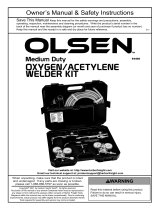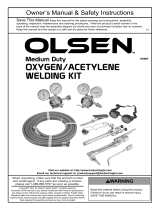Page is loading ...

INSTRUCTIONS for
F-15-243
January, 2001
NO. 1 QUICK-DISCONNECT
TORCH HANDLE
Part No. 21702
These INSTRUCTIONS are for experienced operators. If you are not fully familiar with the principles of operation and safe practices
for air-fuel gas equipment, we urge you to read our booklet Precautions and Safe Practices Form 2035. Do NOT permit untrained
persons to operate this equipment. Do NOT attempt to operate this equipment until you have read and fully understand these
INSTRUCTIONS. If you do not fully understand these INSTRUCTIONS, contact your supplier for further information.
The regulator covered by these instructions is listed by Underwriter's Laboratories only when using parts manufactured by ESAB
Welding & Cutting Products to the specifications on file with Underwriter's Laboratories, Inc., and when they are used in the gas
service for which they are designed and listed. The use of other parts that cause damage or failure to the equipment will void the
manufacturer's warranty.
This sheet covers use of Quick-Disconnect PREST-O-
LITE which attach directly to this torch handle. Supple-
mentary instructions are supplied with quick-disconnect
SWIRLJET air-fuel gas (F-15-242) and SWIRLJET air-
acetylene tips (F-15-241).
CONNECTING:
1. Attach a regulator to your acetylene or fuel gas tank,
following the instructions supplied with the regulator.
2. Connect a 3/16-in. hose assembly with ‘A’-size
lefthand-thread fittings to the regulator outlet and to
the handle. Tighten the connection nuts with a wrench.
NOTE: If using B-size fitting hose, adaptor P/N 18Z56
is required.
3. Pull back on the quick-disconnect sleeve on torch
handle; insert the QD Swirljet tip into the quick-dis-
connect until fully seated; and then release the sleeve.
TEST FOR LEAKS:
Close the shutoff valve on the torch handle. Open the
tank valve, set the regulator to deliver 10 psi (see in-
structions supplied with regulator) and check for leaks,
using a thick solution of soap and water, at the points
indicated on the adjoining sketch.
LIGHTING & FLAME ADJUSTMENT:
1. If you have set the regulator to 10 psi delivery pres-
sure for testing, you may wish to reset it before light-
ing the flame, since only a few tips require a pressure
that high. Unless you are sure 10 psi is needed, we
suggest the regulator be reset for 5 psi (‘B’ setting on
the R-411 Acetylene Regulator) before you light your
torch.
Be sure this information reaches the operator.
You can get extra copies through your supplier.
REGULATOR
TEST FOR LEAKS
NEEDLE
VALVE
QD #1
HANDLE
FITTED HOSE
ASSEMBLY
TIP
NOTE: When using SWIRLJET tips, be sure to follow
the pressure recommendations given in the in-
struction sheets supplied with those tips.

2. Having set or reset your regulator to 5 psi delivery
pressure, open the needle valve on the torch handle,
and light the gas at the tip with a friction lighter.
3. After lighting the torch, adjust the flame size, if nec-
essary, by changing the setting of the regulator pres-
sure-adjusting screw or partially closing the torch
needle.
SHUTTING OFF:
1. For short intervals, merely close the needle valve on
the torch handle.
2. For longer periods, or if you are going to leave the
outfit unattended, close the tank valve as well as the
torch valve.
MAINTENANCE:
1. If the needle valve turns too freely, or there is gas
leakage around the valve stem, tighten the valve stem
packing nut. If leakage persists, replace the valve
stem assembly (P/N 21784).
2. If the needle valve does not shut off complete, re-
move the valve stem assembly and wipe the seating
surfaces on the stem and in the body with a clean
cloth. If the valve stem is bent, or the seating surface
nicked or marred, replace it with a new assembly
(21784).
3. Each torch is equipped with a filter-screw, which holds
a mixer disk in place. If flow of gas through the tip
appears to be restricted, remove the filter-screw with
a 1/8-in. socket key (‘Allen wrench’) and replace both
filter-screw and mixer disk. See F-15-241 or F-15-
242 supplied with the quick-disconnect Swirljet tips.
PRECAUTIONS & SAFE PRACTICES
A. DO NOT let acetylene or LP-Gas escape near any
possible source of ignition. Accumulations of either in
certain proportions may explode if ignited.
B. NEVER store acetylene or LP-Gas tanks (cylinders)
in a closed or confined space, such as a closet, tool
box, or automobile trunk.
C.NEVER solder a container that contains or has con-
tained flammable liquids or vapors (including gaso-
line, benzene, solvents, and other similar materials)
unless the container has been thoroughly purged of
all traces of flammable material and vapors.
D.Before starting work always test for leaks around all
joints with a soapy water solution.
E. NEVER use a flame to test for leaks of flammable
gases.
F. NEVER use a tank with a leaking valve.
G.DO NOT attempt any repairs to an acetylene or LP-
Gas tank, except to tighten the packing-gland nut on
the valve.
H. DO NOT abuse or drop tanks or handle them roughly.
I. NEVER use a tank as a roller or support.
J. NEVER use a hammer, wrench, or pliers on a tank
valve equipped with a handwheel. On small acety-
lene tanks, always use PREST-O-LITE valve wrench
(box type, P/N 505L00).
K. DO NOT open tank valve more than 1-1/2 turns. (Pref-
erably no more than 3/4 of a turn.)
L. Leave valve wrench on tank valve stem so that tank
valve can be closed quickly in case of emergency.
M.NEVER allow full tank pressure to enter the hose.
Always use a regulator when there is a needle valve
on the torch handle.
N.NEVER lay a torch down unless the gas flow has
been shut off. If you want to maintain a pilot flame
when you stop work for short intervals, provide a rack
or stand for the torch, away from combustible materi-
als. Do not leave it unattended unless you are sure
there is no danger of it being disturbed by unautho-
rized persons.
O.Examine your hose for leaks frequently. Dipping it in
a bucket of clean water, with the pressure in the hose,
is the quickest and easiest ways.
P. DO NOT use hose that is worn, or any equipment
that is in need of repairs.
Q.DO NOT start fires. Be very careful when working
near combustible material.
R.Fuel gas tanks (cylinders) are equipped with fusible-
metal safety devices. NEVER store tanks near radia-
tors, furnaces, or other heat sources.
Prest-O-Lite and Swirljet are registered trademarks of ESAB Welding & Cutting Products
F-15-243 01/2001 Printed in U.S.A.
/



